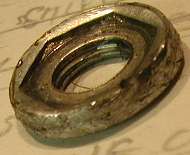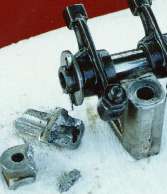The MGA With An Attitude
SOFT STEEL WASHER For Head Bolts - FT-029
 At 10:36 PM 11/17/05, Mike Lupynec wrote:
At 10:36 PM 11/17/05, Mike Lupynec wrote:
"Attached are pics of the bad Moss head stud washer. The crushing was not at all visible as the nut cleanly dug itself into the washer. Only the torque wrench knew something bad was up."
Aside from making it difficult to set the proper torque, this can also cause CATASTROPHIC ENGINE FAILURE. I have had this problem in years past. Apparently it comes back to haunt us occasionally. Moss Motors has been notified of this problem on 18_NOV_95. I will post more information here when available.
 The original MGA head bolt washers were very heavy steel, probably not hardened, but thick enough to be solid and not deform under load. These are the only ones I will use for this application. Thinner soft steel washers are useless, as when they deform the resulting pressure point is hardly larger than the nut itself, similar to having no washer at all. As soon as the washer starts to deform it will turn with the nut and will abrade the surface underneath.
The original MGA head bolt washers were very heavy steel, probably not hardened, but thick enough to be solid and not deform under load. These are the only ones I will use for this application. Thinner soft steel washers are useless, as when they deform the resulting pressure point is hardly larger than the nut itself, similar to having no washer at all. As soon as the washer starts to deform it will turn with the nut and will abrade the surface underneath.
The thin hardened steel washers are equally useless for the MGA. These may work reasonably well against a cast iron cylinder head or on the MGB type cast iron rocker shaft pedestals. When used on top of the MGA type aluminum rocker shaft pedestals, the thin hard steel washers will readily bend and deform into a bowl shape, which in turn will deform the aluminum part underneath. When the aluminum rocker pedestal is impressed in this manner the material is squished inward to constrict on the stud, after which it is difficult to remove the pedestal from the stud. Once there is a bowl shape impression in the pedestal, the material will also be forced outward. The result can be a fractured pedestal which will release the rocker shaft to move upward, which will then disable operation of the rocker arms and valves.
If this should happen at high engine speed it may also result in dislocation of the pushrod to put the adjuster ball on the top edge of the socket. This in turn may result in overtravel of the valve which may hit the top of the block to bend the valve stem. That can jam the valve in the guide, causing the valve to be hit by the piston, possibly damaging the piston, and possibly pushing the valve guide out the top of the head.
|